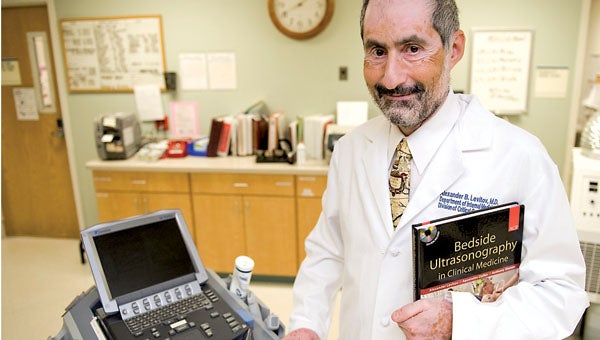Pocket-sized innovation
Published 8:11 pm Saturday, November 20, 2010

Dr. Alexander Levitov, professor of internal medicine at Eastern Virginia Medical School, believes doctors everywhere soon will be carrying an ultrasound machine on their belt buckles.
Despite medical and technological advancements in the past century, one thing has not changed — stethoscopes and doctors’ hands have remained the standard tools for diagnostics since the Civil War.
That may change soon, according to one doctor and author.
Dr. Alexander B. Levitov, professor of internal medicine at Eastern Virginia Medical School and author of “Bedside Ultrasound in Clinical Medicine” and “Critical Care Ultrasonography,” feels that doctors will soon trade in their stethoscopes for pocket-sized ultrasound machines.
“The stethoscope could be replaced by or be extremely complimentary to the machine,” Levitov said. “For years a doctor has come in, listened to your heart and lungs and pushed on your tummy. That procedure hasn’t changed since the Civil War. This is the first advancement to be made in that field.”
While advanced technology has been in the works for the past five years, pocket-sized ultrasounds, which run between $5,000 and $10,000, have been available for about the last year, according to Levitov.
The ultrasounds are approximately the size of a Blackberry and flip open to reveal a screen. A wand-like piece detaches and is used to take the image. A doctor can wear it on his belt while he makes rounds. The rechargeable battery lasts four to five hours, according to Levitov.
While ultrasound technology has traditionally has been limited to examination of the heart and monitoring fetal development, the machines — which peer inside the body and instantly provide valuable information — can be used to examine the entire body.
“A surgeon can look for blood in the belly, a lacerated liver or for a broken bone in a person’s foot,” Levitov said, offering a few examples. “An eye doctor can look into the eyeball. An OB/GYN can look at the uterus. There is no part of the body that this cannot be used on.”
The machine also serves to benefit patients and provide improved alternatives to traditional procedures.
“It will shorten the time of diagnosis for a patient dramatically and can be used to replace something like an X-ray that would expose the patient to radiation,” Levitov said. “Many conditions — such as a ripped ligament or an ulcer — can be difficult to see when a patient isn’t moving. The use of a traditional X-ray doesn’t always allow you to see the problem. CT scans and X-rays are just photos, but an ultrasound is a video that you can capture in real time.”
The portability of the smaller machines also makes them a “great equalizer” in the provision of care, he says. “They can be taken into less affluent communities, and it allows the practitioner to make a diagnosis on the spot.”
The machines have already been taken on expeditions to Mount Everest and the international space station.
The next step will be common use in health care facilities.
According to a spokesperson at Bon Secours Health Care Systems, the organization hasn’t purchased any units because it doesn’t feel their battery life is feasible for a large health care system that sees hundreds of patients throughout the course of the day.
Levitov estimated, however, that the machine will be used more commonly within the next five years, as more doctors train with the device.
“The challenge is getting retaining medics to use it,” Levitov said. “The medical education is where the bottleneck occurs.”


